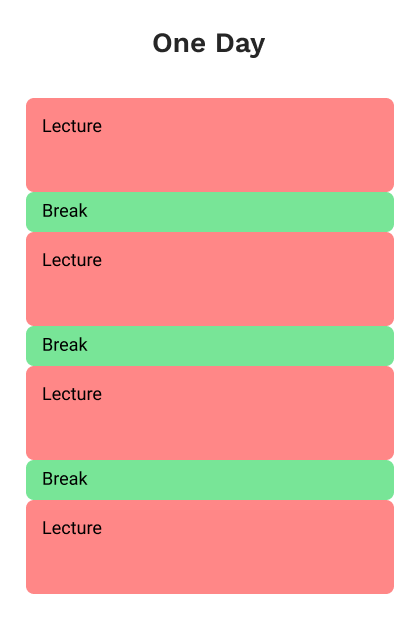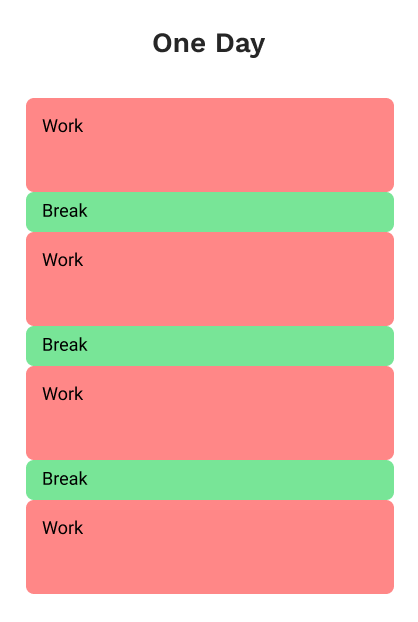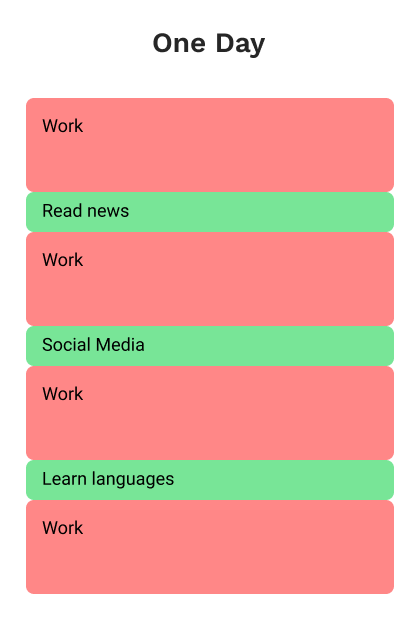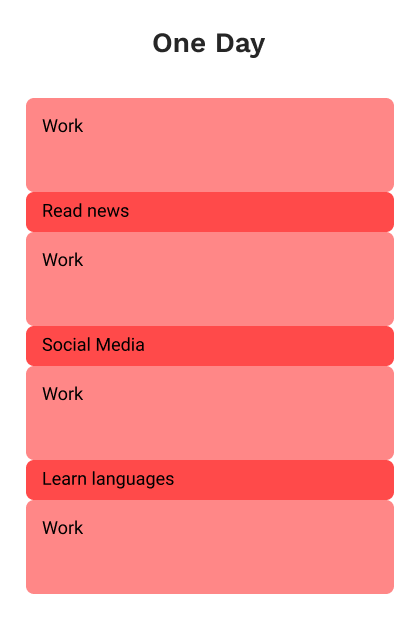Redefine “take a rest”
When I was still in middle school, I didn’t have a laptop and there was no such thing as a smartphone. I vaguely remember that we had many lectures in a single day and the break between the lectures only lasted 10 minutes. My classmates and I would use up the 10 minutes to play games, listen to music, or take a power nap. In that 10 minutes, it was clear to us that we were taking a rest.
If I could illustrate one of my days in middle school in a calendar view (red for occupied, green for rest), it would look like this:
After graduating from the university, I started to work as a developer in Beijing, China. The smartphone was invented, but it was not so popular. Mobile Internet was still very expensive. Most people haven’t acquired the habit of staring at the phone all the time yet. After working for a while, my colleagues would talk to each other or play some casual games together. I went to the gym or met friends after getting off work. In that period, it was clear to me that when I was not working, I was taking a rest. My day would look like this:
Then the smartphone got popular. Lots of apps emerged. Suddenly, we had a powerful tool to do many things at any time. People started talking about how to make use of the fragmented time. For example, you could reply to emails or learn new languages using apps on your smartphone while waiting for a bus. I liked the idea and tried to boost my efficiency as much as possible. After and after, the apps changed my lifestyle. When I finished one task at work, instead of idling, I would pick up my phone to learn English, read the news, or check social media. While I was doing these things, I still thought I was taking a rest because I was obviously not working, right? My day changed to something like this:
What happened next was the so-called “attention economy.” Tech companies realized that the more attention they could get from the user, the more profit would follow. Thus they started to trap you in their apps by all means, including introducing gamification to the products, personalizing your newsfeed, creating recommendation algorithms, etc. Apparently, the best way to keep you engaged is to stimulate your nerves as much as possible. They’ll hook you successfully if you’re always longing for new likes or furious at a clickbait headline. So my brain is not resting, if not busier, while I’m reading news online or checking social media. Nowadays, I’m constantly surrounded by overstimulation whenever I pick up my phone. Accordingly, the illustration of my day should look like this:
In fact, I was not taking a rest when I was not working. But that’s not the problem. The problem is I thought I was. If I were conscious that I was not resting, I wouldn’t tire myself for too long. However, when I thought I was already taking rest frequently, I would just keep going until I was exhausted. Now I know why I was fatigued every day, although I didn’t work constantly.
“I’m automatically taking a rest when I’m not working,” this notion no longer applies to this digital age saturated with overstimulation. The opposite is true: “My brain is always engaged unless I take a rest intentionally.” It sounds a little bit contradictory, but we can’t take a rest anymore without some effort. To maintain our mental health, we must redefine “take a rest.”
After taking a long hard look at my daily activities, I found out that I’m taking rest only when I’m meditating, exercising, or sleeping. Since then I would force myself to do these three activities whenever I’m tired. It works great for me.
If you feel exhausted every day although there aren’t many things to do, maybe you should be more aware of your daily activities and learn how to take a real rest.






